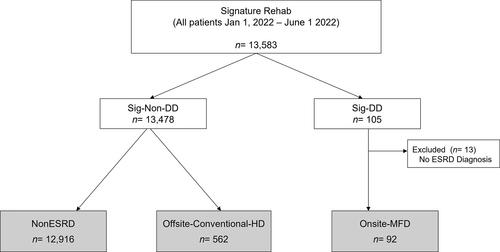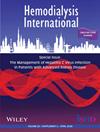Improved nursing home end-stage renal disease patient participation in physical therapy with onsite, more frequent dialysis
Abstract
Introduction
For end-stage renal disease (ESRD) patients residing in skilled nursing facilities (SNFs), the logistics and physical exhaustion of life-saving hemodialysis therapy often conflict with rehabilitation goals. Integration of dialysis care with rehabilitation programs in a scalable and cost-efficient manner has been a significant challenge. SNF-resident ESRD patients receiving onsite, more frequent hemodialysis (MFD) have reported rapid post-dialysis recovery. We examined whether such patients have improved Physical Therapy (PT) participation.
Methods
We conducted a retrospective electronic medical records review of SNF-resident PT participation rates within a multistate provider of SNF rehabilitation care from January 1, 2022 to June 1, 2022. We compared three groups: ESRD patients receiving onsite MFD (Onsite-MFD), ESRD patients receiving offsite, conventional 3×/week dialysis (Offsite-Conventional-HD), and the general non-ESRD SNF rehabilitation population (Non-ESRD). We evaluated physical therapy participation rates based on a predefined metric of missed or shortened (<15 min) therapy days. Baseline demographics and functional status were assessed.
Findings
Ninety-two Onsite-MFD had 2084 PT sessions scheduled, 12,916 Non-ESRD had 225,496 PT sessions scheduled, and 562 Offsite-Conventional-HD had 9082 PT sessions scheduled. In mixed model logistic regression, Onsite-MFD achieved higher PT participation rates than Offsite-Conventional-HD (odds ratio: 1.8, CI: 1.1–3.0; p < 0.03), and Onsite-MFD achieved equivalent PT participation rates to Non-ESRD (odds ratio: 1.2, CI: 0.3–1.9; p < 0.46). Baseline mean ± SD Charlson Comorbidity score was significantly higher in Onsite-MFD (4.9 ± 2.0) and Offsite-Conventional-HD (4.9 ± 1.8) versus Non-ESRD (2.6 ± 2.0; p < 0.001). Baseline mean self-care and mobility scores were significantly lower in Onsite-MFD versus Non-ESRD or Offsite-Conventional-HD.
Discussion
SNF-resident ESRD patients receiving MFD colocated with rehabilitation had higher PT participation rates than those conventionally dialyzed offsite and equivalent PT participation rates to the non-ESRD SNF-rehabilitation general population, despite being sicker, less independent, and less mobile. We report a scalable program integrating dialysis and rehabilitation care as a potential solution for ESRD patients recovering from acute hospitalization.


 求助内容:
求助内容: 应助结果提醒方式:
应助结果提醒方式:


